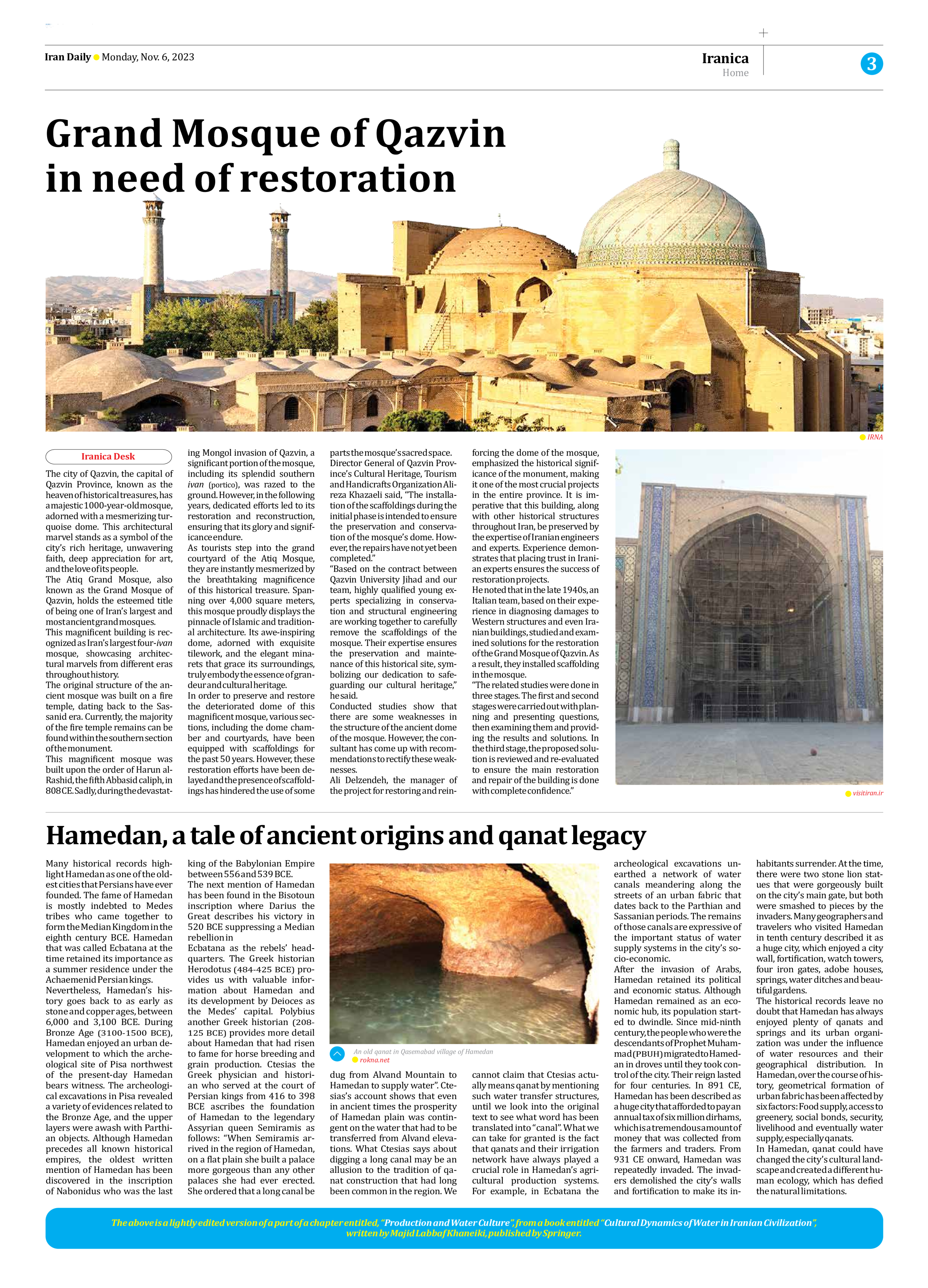
Grand Mosque of Qazvin in need of restoration
The city of Qazvin, the capital of Qazvin Province, known as the heaven of historical treasures, has a majestic 1000-year-old mosque, adorned with a mesmerizing turquoise dome. This architectural marvel stands as a symbol of the city’s rich heritage, unwavering faith, deep appreciation for art, and the love of its people.
The Atiq Grand Mosque, also known as the Grand Mosque of Qazvin, holds the esteemed title of being one of Iran’s largest and most ancient grand mosques.
This magnificent building is recognized as Iran’s largest four-ivan mosque, showcasing architectural marvels from different eras throughout history.
The original structure of the ancient mosque was built on a fire temple, dating back to the Sassanid era. Currently, the majority of the fire temple remains can be found within the southern section of the monument.
This magnificent mosque was built upon the order of Harun al-Rashid, the fifth Abbasid caliph, in 808 CE. Sadly, during the devastating Mongol invasion of Qazvin, a significant portion of the mosque, including its splendid southern ivan (portico), was razed to the ground. However, in the following years, dedicated efforts led to its restoration and reconstruction, ensuring that its glory and significance endure.
As tourists step into the grand courtyard of the Atiq Mosque, they are instantly mesmerized by the breathtaking magnificence of this historical treasure. Spanning over 4,000 square meters, this mosque proudly displays the pinnacle of Islamic and traditional architecture. Its awe-inspiring dome, adorned with exquisite tilework, and the elegant minarets that grace its surroundings, truly embody the essence of grandeur and cultural heritage.
In order to preserve and restore the deteriorated dome of this magnificent mosque, various sections, including the dome chamber and courtyards, have been equipped with scaffoldings for the past 50 years. However, these restoration efforts have been delayed and the presence of scaffoldings has hindered the use of some parts the mosque’s sacred space.
Director General of Qazvin Province’s Cultural Heritage, Tourism and Handicrafts Organization Alireza Khazaeli said, “The installation of the scaffoldings during the initial phase is intended to ensure the preservation and conservation of the mosque’s dome. However, the repairs have not yet been completed.”
“Based on the contract between Qazvin University Jihad and our team, highly qualified young experts specializing in conservation and structural engineering are working together to carefully remove the scaffoldings of the mosque. Their expertise ensures the preservation and maintenance of this historical site, symbolizing our dedication to safeguarding our cultural heritage,” he said.
Conducted studies show that there are some weaknesses in the structure of the ancient dome of the mosque. However, the consultant has come up with recommendations to rectify these weaknesses.
Ali Delzendeh, the manager of the project for restoring and reinforcing the dome of the mosque, emphasized the historical significance of the monument, making it one of the most crucial projects in the entire province. It is imperative that this building, along with other historical structures throughout Iran, be preserved by the expertise of Iranian engineers and experts. Experience demonstrates that placing trust in Iranian experts ensures the success of restoration projects.
He noted that in the late 1940s, an Italian team, based on their experience in diagnosing damages to Western structures and even Iranian buildings, studied and examined solutions for the restoration of the Grand Mosque of Qazvin. As a result, they installed scaffolding in the mosque.
“The related studies were done in three stages. The first and second stages were carried out with planning and presenting questions, then examining them and providing the results and solutions. In the third stage, the proposed solution is reviewed and re-evaluated to ensure the main restoration and repair of the building is done with complete confidence.”







